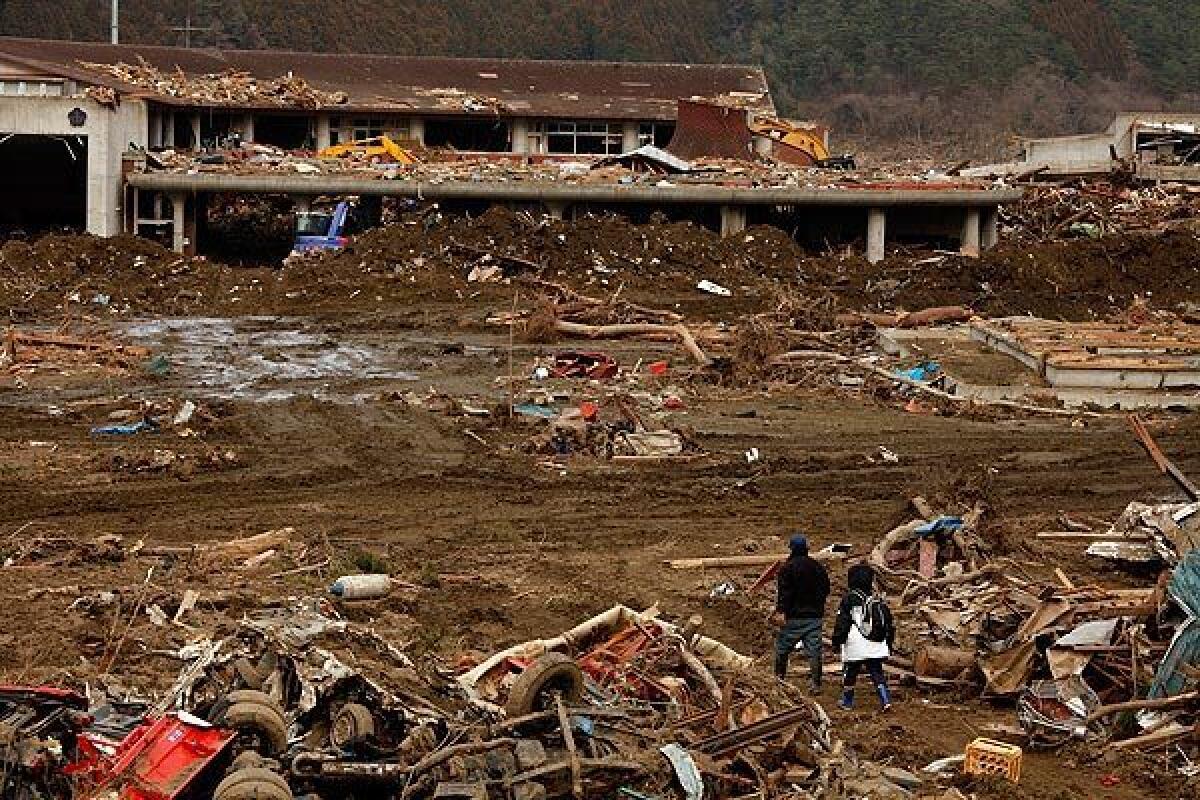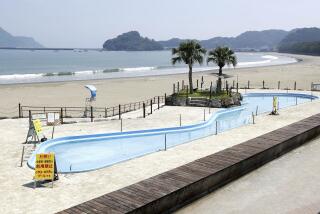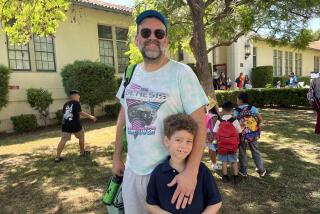Parents in Japan comb through school that’s now a graveyard

Tatsuhiro Karino paused at the top of the muddy hill, took his wife, Masako, by the hand and led her slowly down to the ruins of the elementary school that entombed the body of their daughter, Misaki.
Dwarfed by four mammoth cranes digging into the wreckage, the 40ish construction worker gently pulled a veil over his wife’s face to shield her from the dust and whiff of death.
But he couldn’t protect her from this: the grim task of locating the body of their 8-year-old child, among the 94 students and teachers killed when their school was leveled March 11 in nature’s twin strike of shaking ground and torrential wave.
The couple, who also lost their 11-year-old son, Tetsuya, in the devastation, Tuesday joined a clutch of fellow parents asking the same maddening question: How could so many children among the 108 at the school have perished when they followed all the safety rules for a natural disaster?
Authorities in this coastal town attribute the deaths to a turn of events no one had anticipated. With its first violent jolt, the magnitude 9 earthquake killed 10 teachers at Ookawa Elementary School, plunging the students into chaos.
Survivors say the children were urged by three remaining instructors to follow a long-practiced drill: Don’t panic, just walk single file to the safety zone of the school’s outdoor playground, an area free of falling objects.
For nearly 45 minutes, the students stood outside and waited for help. Then, without warning, the monstrous wave swept in, demolishing what was left of the school and carrying most of the students to their deaths. Twenty-four survived.
“Those children did everything that was asked of them, that’s what’s so tragic,” said Haruo Suzuki, a former teacher here. “For years, we drilled earthquake safety. They knew an event like this wasn’t child’s play. But no one ever expected a killer tsunami.”
Photos: Parents search rubble of school for their children
Across Japan’s northeastern coast, at least 125 students from kindergarten to college have been confirmed dead, with about 1,600 still missing, authorities say.
Most of those deaths occurred here, at a school that sat in a scenic glen shaded by towering pine trees. But on Tuesday, the Karinos could see none of the beauty of their surroundings as they picked through the piles of debris in search of their daughter.
Earlier in the day, while walking amid a small cadre of soldiers under gray skies, Tatsuhiro Karino had spotted something he both did and didn’t want to see: the body of his son.
“I saw his face and I knew it was him right away,” he said. “I knelt down next to him and I told him that I already missed him.”
Workers carried the boy’s small frame up a muddy rise from the school, laying it beside several other covered bodies. Masako Karino calmly lifted the brown shroud from her child’s face, and she and her husband moved their hands along the body, a silent gesture of reassurance, as if to say, “Everything is going to be OK, son.” Then, slowly, they carried his body to a waiting truck.
“He was so clever,” Tatsuhiro said later as he sat on a curb consoling his wife. “He wanted to one day design computer games. He loved the cookies his mother made. I’ll always remember that.”
Nearby, workers opened the shroud of each arriving corpse, wiping down the faces with water to help in the identification process, as hovering parents picked through recovered personal effects: a basketball, sports team photos, a row of prim red backpacks.
Suddenly, one man dropped to his knees and wailed at the sight of a body being loaded into a truck.
There was anger mixed with the grief. Some parents refused to attribute the deaths to a cruel twist of fate.
“The teacher should have gotten those children to a higher place,” said Yukiyo Takeyama, who lost two daughters, aged 9 and 11.
Speaking as though in a trance, she explained that she initially wasn’t worried the day the earthquake struck because her daughters had always talked of the disaster drill they knew by heart. But hours afterward, there was still no word from the school.
At dawn the following day, her husband, Takeshi, drove out toward the school until the road buckled and disappeared underwater. He walked the rest of the way, reaching the clearing near the river where he had delivered his children countless times.
“He said he just looked at that school and he knew they were dead,” Takeyama said. “He said no one could have survived such a thing.” She paused and sobbed. “It’s tragic.”
Soon after bidding farewell to their son, the Karinos were once again holding hands, back amid the mountains of wreckage, looking for their second child. At one point, Tatsuhiro broke free and rushed to pull a twisted gray bicycle from the rubble, then turned away in silence. It wasn’t Misaki’s.
“I travel in my job and I would call home every night and talk to her,” he recalled. “She would say, ‘Dad, I miss you. Come home.’ ”
As the heavy machinery rumbled past, the couple continued their search, passing a broken wall bearing the inscription by Japanese writer Kenji Miyazawa that had been hand-painted by students long before the tsunami.
“We will not be beaten by the rain or the wind or the storms,” it read.
More to Read
Sign up for Essential California
The most important California stories and recommendations in your inbox every morning.
You may occasionally receive promotional content from the Los Angeles Times.











